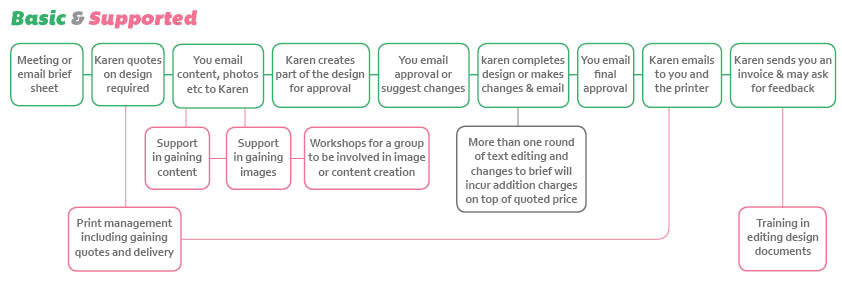Karen Batten uses a distinct process of service, involving consultation and collaboration in developing creative products. This process places clients and service users at the centre of the creative process through dialogue, workshops and training which is applicable to a range of clients including individuals, organisations and businesses. Karen creates opportunities for the service users, members and staff to be involved in the creative process, where-ever the interest lies. This process of greater consultation and collaboration has proven to not only yield greater results, but also creates a climate of creativity within organisations, ensures client’s ideas are utilised and fosters a sense of creative ownership over the final product. Karen weaves evaluation and reflection into every project to continuously improve the process.
All artwork created is owned by the client. Karen can provide training for workers to edit the designs created to save resources for future projects.
Below is a diagram of different models of creating print and web design. Most design jobs go through the Basic process often with the addition of printing support.
Projects that require a consultative and collaborative process, can be tailored to suit the needs of the client. A typical outline may include the following:
Consults
Individuals, organisations and businesses are consulted to gain clear information about the desired creative product outcome. Organisations’ service users can also be involved in the process. Service users are the target audience of an organisation. Consulting with the target audience is a great way to find out how to attract more service users. This also creates an environment where service users feel valued, involved and develop a sense of ownership. In turn, this leads to the service users encouraging their peers to participate in the organisation or business thereby attracting more people to the service. Personal recommendations are the most powerful marketing tool.
What’s involved in the Consults stage?
Creative facilitation techniques are used with staff, members and service users to draw out ideas, images, opinions and visions for the creative product. Facilitation styles and activities are tailored to the participants’ preferred engagement styles. For participant groups with low attention spans or limited time, ready-made images and wording examples can be used. For more engaged participants the foundation of marketing can be discussed and content developed by the group.
Karen’s client is again consulted on the outcome of this first stage before proceeding to development of the creative product.
Collaborates
The preferred method for the Collaborates stage of the process involves delivering two specific creative workshops. These collaborative or mentoring workshops with service users create opportunities for skills development in marketing, design and production.
In practice, the Consults and Collaborates stages can overlap depending on the creative product and participants’ interest in the process. For instance, sometimes it is difficult to tell whether participants will be more interested in being consulted or in collaborating prior to the process commencing. Karen builds in flexibility and reflection to all stages to ensure the process is responsive to emerging needs and interests of the participants.
What’s involved in the Collaborates stage?
A creative workshop plan is designed according to the creative product required and the participant’s engagement needs.
Sample workshop plan
Workshop 1: Marketing Foundation. This workshop aims to identify the promotional strategies and materials required by brainstorming the marketing needs for the project such as target audience, numbers and the organiser’s goals. Having an understanding of developing a promotional strategy specific to an organisation will inspire the content for the chosen material. The workshop will combine basic marketing education with drawing out the inside knowledge and expertise of participants.
Workshop 2: Promotional Aesthetic & Concept. This second workshop explores the visual aesthetic component to the promotional material by brainstorming ideas through creative expression activities and art making. By the end of these workshops, we will aim to have a clear idea, design aesthetic and concept for all promotional material required. This creative workshop provides an opportunity for participants to express themselves through hands-on creative activities. Participants are given an opportunity to be involved in visual representation that reflects their life.
Some participants find it easier and more useful to reflect on the workshop ideas in their own time. Having two workshops creates an opportunity for participants to share and grow ideas both inside and outside of the workshop space. This creates opportunities for participants to be collaborative ways that suits them.
Karen’s client is again consulted on the outcome of this second stage before proceeding to development of the creative product.
Creates
Karen then creates products according to the aesthetics, concepts, images, ideas and visions generated through the Consults-Collaborates process.
Participant Mentoring & Skills Development: participants can also become involved in the design process through one on one mentoring or skill sharing workshops on graphic design, film and animation.
